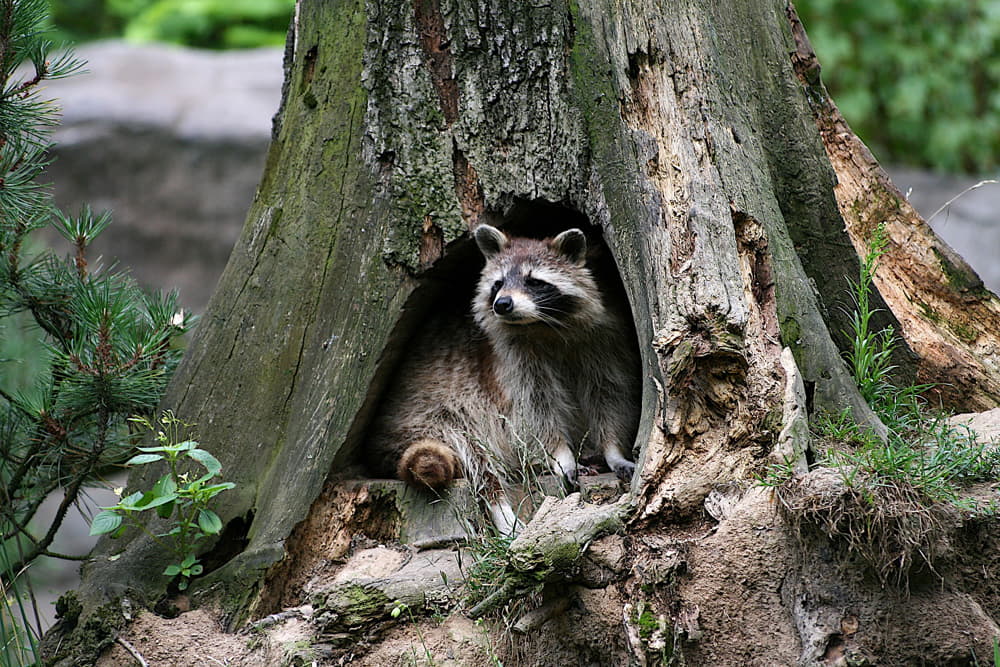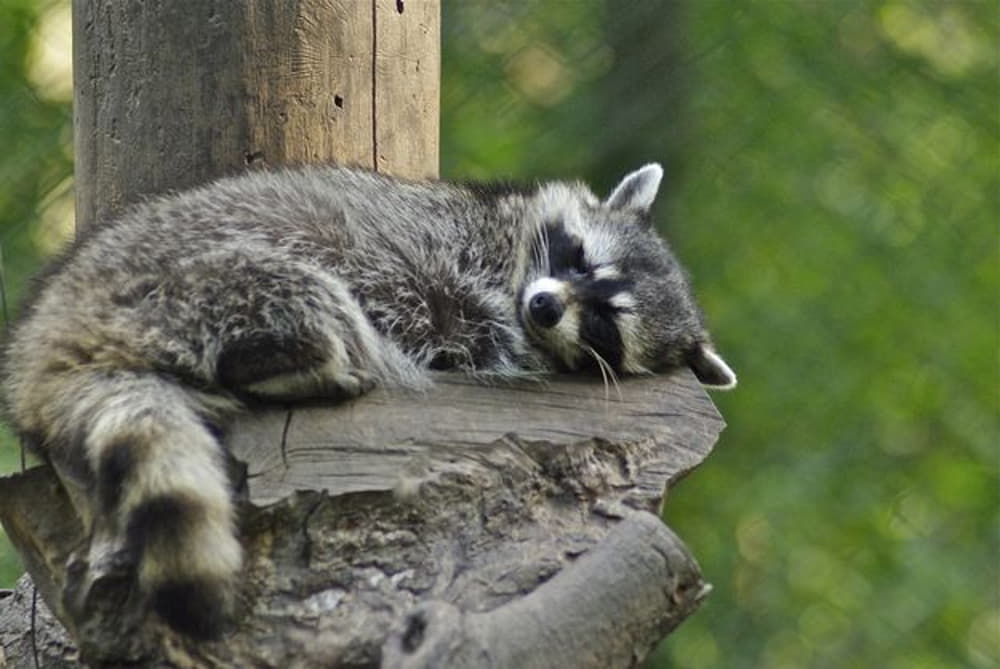Have you ever wondered where do raccoons sleep? These clever creatures are often seen scavenging for food in urban areas, but their sleeping habits remain a mystery to many. Raccoons are fascinating animals with unique behaviors that adapt to their environment. Understanding where they sleep is essential for coexisting peacefully with them in both natural and urban settings.
Raccoons are nocturnal animals, meaning they are most active at night. During the day, they retreat to safe and secure locations to rest. Their choice of sleeping spots depends on several factors, including availability, safety, and climate. By learning about their sleeping habits, we can better understand their behavior and protect their natural habitats.
In this article, we will explore the world of raccoon sleeping patterns, including their preferred locations, seasonal changes, and how they adapt to urban environments. Whether you're a wildlife enthusiast or someone dealing with raccoon encounters, this guide will provide valuable insights into the mysterious lives of raccoons.
Read also:Ssh Iot Anywhere Free Unlocking Secure Remote Access For Your Iot Devices
Table of Contents
- Natural Habitat and Den Sites
- Urban Adaptation: Where Do Raccoons Sleep in Cities?
- Seasonal Changes in Raccoon Sleeping Patterns
- The Structure of Raccoon Dens
- Common Locations for Raccoon Sleep
- Safety Concerns: Why Raccoons Choose Certain Sleeping Spots
- Behavioral Characteristics of Raccoon Sleep
- Human Interaction and Managing Raccoon Presence
- Conservation Efforts for Raccoon Habitats
- Final Thoughts on Raccoon Sleep
Natural Habitat and Den Sites
Raccoons are highly adaptable animals, but their natural habitat primarily consists of wooded areas, forests, and wetlands. In these environments, they seek out den sites that provide protection from predators and harsh weather conditions. Trees, hollow logs, and rock crevices are common choices for their dens.
Types of Natural Den Sites
Raccoons have a preference for elevated and enclosed spaces when choosing their dens. Some of the most common natural den sites include:
- Hollow trees
- Caves
- Abandoned burrows
- Rock formations
According to the National Geographic, raccoons often use multiple den sites within their home range, rotating between them to avoid detection by predators.
Urban Adaptation: Where Do Raccoons Sleep in Cities?
As urbanization continues to expand, raccoons have learned to thrive in city environments. Their adaptability allows them to find suitable sleeping spots even amidst the hustle and bustle of urban life. In cities, raccoons often seek shelter in man-made structures, taking advantage of the availability of food and protection.
Common Urban Den Sites
In urban areas, raccoons may sleep in:
- Attics
- Basements
- Under decks
- Abandoned buildings
A study published in the Journal of Urban Ecology highlights how raccoons adapt their behavior to urban environments, often choosing locations close to food sources such as trash bins and gardens.
Read also:Unveiling The Ultimate League Of Legends Wrapped 2024 Experience
Seasonal Changes in Raccoon Sleeping Patterns
Raccoon sleeping habits change with the seasons, influenced by factors such as temperature, food availability, and breeding cycles. During colder months, raccoons may spend more time in their dens to conserve energy and stay warm.
Winter Hibernation
While raccoons do not truly hibernate, they enter a state of torpor during the winter. This involves reducing their activity levels and staying in their dens for extended periods. They rely on stored body fat to sustain them during this time.
Research from the U.S. Geological Survey shows that raccoons in colder climates may spend up to 70% of their time in their dens during the winter months.
The Structure of Raccoon Dens
Raccoon dens are designed to provide safety, warmth, and comfort. The structure of their dens varies depending on the location and available materials. Natural dens, such as hollow trees, offer insulation and protection from the elements, while urban dens may consist of makeshift shelters created from debris and human-made materials.
Features of an Ideal Raccoon Den
An ideal raccoon den includes:
- A small entrance to deter predators
- Sufficient space for movement
- Insulation for warmth
- Proximity to food and water sources
These features ensure that raccoons can rest safely and comfortably during the day, preparing them for their nocturnal activities.
Common Locations for Raccoon Sleep
Whether in the wild or in urban areas, raccoons have a range of preferred sleeping locations. Understanding these locations can help us better manage their presence in our environments.
Top 5 Common Raccoon Sleeping Spots
- Hollow trees
- Attics
- Abandoned burrows
- Under decks
- Caves
These locations provide the necessary elements for a safe and secure sleeping environment, ensuring the survival of raccoons in various habitats.
Safety Concerns: Why Raccoons Choose Certain Sleeping Spots
Raccoons prioritize safety when selecting their sleeping spots. They choose locations that minimize the risk of predation and environmental hazards. Understanding their safety concerns can help us address potential conflicts with raccoons in urban areas.
Predators and Threats
Common predators of raccoons include:
- Coyotes
- Birds of prey
- Bears
By choosing enclosed and elevated den sites, raccoons reduce their exposure to these predators, increasing their chances of survival.
Behavioral Characteristics of Raccoon Sleep
Raccoons exhibit unique behavioral characteristics when it comes to sleep. Their sleeping patterns are influenced by their nocturnal nature and social structure. Understanding these behaviors can provide insight into their daily lives.
Social Structure and Sleep
Raccoons are generally solitary animals, but they may share dens with other raccoons during certain times of the year. This behavior is more common in colder climates, where shared body heat can help conserve energy.
Research from the Wildlife Conservation Society indicates that raccoons may adjust their sleeping patterns based on the presence of other animals in their territory.
Human Interaction and Managing Raccoon Presence
Coexisting with raccoons in urban environments requires a balance between respecting their needs and protecting human property. Proper management of raccoon presence can prevent conflicts and ensure the well-being of both humans and animals.
Tips for Managing Raccoon Presence
- Secure trash bins to prevent scavenging
- Seal potential entry points to homes
- Avoid leaving pet food outdoors
- Install motion-activated lights to deter raccoons
By implementing these strategies, we can reduce the likelihood of raccoon-related issues while promoting peaceful coexistence.
Conservation Efforts for Raccoon Habitats
Protecting raccoon habitats is essential for maintaining biodiversity and ecological balance. Conservation efforts focus on preserving natural areas and promoting sustainable practices that benefit both wildlife and humans.
Key Conservation Initiatives
- Establishing wildlife corridors to connect fragmented habitats
- Implementing urban planning that incorporates green spaces
- Raising awareness about the importance of wildlife conservation
Organizations such as the World Wildlife Fund play a crucial role in advocating for the protection of raccoon habitats and other wildlife species.
Final Thoughts on Raccoon Sleep
In conclusion, understanding where raccoons sleep is essential for appreciating their adaptability and resilience. From natural habitats to urban environments, raccoons have demonstrated remarkable flexibility in choosing their sleeping spots. By learning about their behaviors and needs, we can better manage their presence and promote coexistence.
We encourage you to share your thoughts and experiences with raccoons in the comments below. Have you encountered raccoons in your area? How do you manage their presence? Additionally, feel free to explore other articles on our site for more insights into wildlife and conservation efforts.

